Don Davis
Painter and animator, born Oct.
21, 1952.
I grew up in the San Francisco Bay area, interested in space related things ever since Sputnik 1 was announced to our Kindergarten class. One day my Mother gave me a copy of 'The World We Live In', the classic book by Life compiled from a series of articles appearing in the weekly news picture magazine. Probably never has any one volume presented such a rich collection of excellent nature artists. At the start and end of this fantastic volume the paintings of Chesley Bonestell provided visions of both the dramatic forging of the Primordial Earth and the cosmic context to the world the bulk of the book presented.
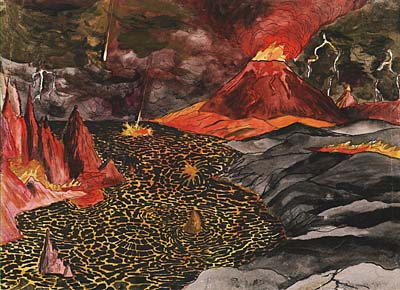
The elementary school I attended was Luther Burbank School in San Jose, where I painted in art classes visions inspired by Bonestell. This watercolor was done in late 1964, after I had turned 12. It is the earliest surviving work by my hand
After a tumultuous High School
life in the late 1960's I graduated from Menlo Atherton High School,
class of 1970. Aside from High School I have had no formal art
training, although a number of painters provided generous artistic
and professional advice in my formative days.
In the late 1960's the U.S. Geological
Survey's branch of Astrogeologic Studies was involved in a hiring
program for high school students as go-fors and for hand coloring
copies of geologic maps, long before the days of color printers. 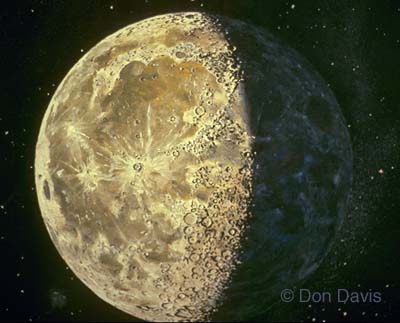 I brought a recently finished oil painting
of the Moon to my job interview in late October 1968. The Geologist,
Don Wilhelms, hired me on the spot and soon I graduated to working
as an illustrator for the branch of Astrogeology. Among the projects
Wilhelms envisioned for me were a series of portrayals of the
Moon in its early history. Artwork of geological features
as they developed have periodically appeared in geological literature,
but these were global images of a world whose battered history
was just being unveiled.
I brought a recently finished oil painting
of the Moon to my job interview in late October 1968. The Geologist,
Don Wilhelms, hired me on the spot and soon I graduated to working
as an illustrator for the branch of Astrogeology. Among the projects
Wilhelms envisioned for me were a series of portrayals of the
Moon in its early history. Artwork of geological features
as they developed have periodically appeared in geological literature,
but these were global images of a world whose battered history
was just being unveiled. 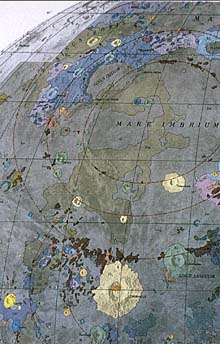
Don Wilhelms and Jack McCauley were the principal authors of the great Lunar Earth side Geologic map, nearly a decade in the making. With it the relative ages of features of the Moon were shown and I was able to first remove the most recent craters from the fresh maria lavas, and then in the more ancient scene remove the maria from most of the surface and generalize what lay beneath based on unburied examples of similar features. The fascinating thing for me through the project was that the relative ages of these features were well known but the absolute ages couldn't be given until samples from the Moon were returned, months after the paintings completion! These appeared in Icarus, 'Two former faces of the Moon' Wilhelms and Davis, Volume 15 no. 3, December 1971. Carl Sagan was then editor of Icarus, and when I met him soon after its publication he complimented me on the work and related the care he took to make sure the reproductions preserved the detail as much as possible.
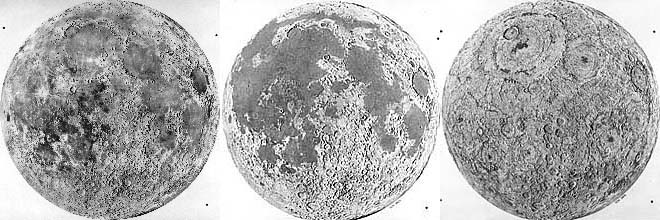
The Moon as it is now (left) and as it was when the last maria lavas were done spreading over the lowlands about 3 billion years ago, and when era of giant basin forming impacts had ended some 3.8 billion years ago.
The Present Moon (A.C.I.C. L.E.M.-1 mosaic, 548K), Eratosthenian age Moon (500K), and Late Imbrium age Moon (660K). In addition to the above, another Public Domain image provided is A 2300 pixel wide jpeg of the Geologic map of the Earth facing side of the Moon (1.3MB) An excellent scan of the entire map sheet can be had here.
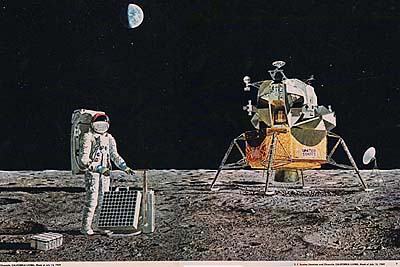 At that time, a visit to the Menlo Park office from the science
writer for the San Francisco Chronicle took place, with my supervisor
Don Wilhelms among those interviewed. When asked for some new
images, Don suggested I be consulted, showing as an example my
earlier 'Apollo 8 in Lunar orbit' painting.
At that time, a visit to the Menlo Park office from the science
writer for the San Francisco Chronicle took place, with my supervisor
Don Wilhelms among those interviewed. When asked for some new
images, Don suggested I be consulted, showing as an example my
earlier 'Apollo 8 in Lunar orbit' painting.
This led to my first commissioned and published piece
of art, a concept of Apollo 11 on the lunar surface based on spacecraft
photos from previous missions, notably Apollo 9. Some details
were wrong, but it was a big break.
This was published the week of the landing in 'California Living,'
the San Francisco Examiner-Chronicle's Sunday supplement.
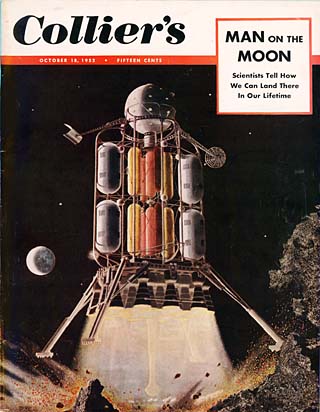 As it
happened, a Bonestell painting of a moon landing was on the cover
of Collier's the week I was born. This appeared 17 years before
the landing, and was incidentally repainted by Chesley for a current
Popular Science article comparing the concepts then with the imminent
reality. The concepts of old he had long painted were dissolving
into fantasy at that time, yet Chesley had the satisfaction to
live to know and paint many of these worlds as they really were.
As it
happened, a Bonestell painting of a moon landing was on the cover
of Collier's the week I was born. This appeared 17 years before
the landing, and was incidentally repainted by Chesley for a current
Popular Science article comparing the concepts then with the imminent
reality. The concepts of old he had long painted were dissolving
into fantasy at that time, yet Chesley had the satisfaction to
live to know and paint many of these worlds as they really were.
At the time of the initial Moon landings there was a large show of Bonestell originals in Palo Alto, and I was able to closely inspect many of his famous images and begin to see how they were done.
At the U.S. Geological Survey I was to learn of the forces which shape the landscapes of other worlds. Even in earthly scenes, the geologists liked to point out what looked natural and what didn't, and what made the scenery look like it did.
My
own efforts in Space painting began to incorporate knowledge of
the surfaces of the Moon and Mars practically as it was being
gathered. The battered cratered rubble covered Moon is given a
characteristic small scale rough texture by the many tiny meteors
steadily stirring the soil over time. Any given millimeter sized
piece of debris whizzing through the inner Solar System is about
10 times as plentiful as a given centimeter sized piece, and the
ratio of crater sizes reflect this. Understanding cratering is
thus an important aspect to visualizing and painting Lunar and
many airless landscapes.
Among the dozens of meteor craters on Earth today, most are in varying stages of being erased with one exception.
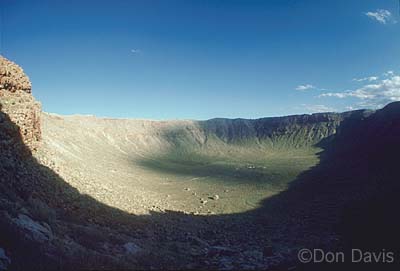
Meteor Crater in Northern Arizona is nearly a mile wide, about 50 thousand years old, and formed in a region which has been relatively arid much of the time since. The conceptual breakthrough in recovering the detailed story of the brief events which formed this impact crater were made by Dr. Eugene Shoemaker, creator and first chief geologist of the U.S. Geological Surveys branch of Astrogeologic studies.
The art of numerical simulations of complex shock wave effects was later brought to bear on impact crater formation largely through the efforts of David Roddy. Through him some of the 'black arts' of atomic weapons design were applied to showing how rare but extreme forces unleashed in impact events behave in rock layers of known thickness and strength.
Mars steadily revealed itself to the cameras of the orbiting Mariner 9 spacecraft in the second half of 1971. The best maps of Mars available then were 'in house' USGS photo mosaics reproduced on large photo sheets. Two views were shown of Mars on each of these sheets, one view of my black and white Mars globe painted earlier during my stint in the Astrogeology Branch headquarters in Flagstaff, the other view of the same region with rows of small photos laid down where they belonged. It was intriguing to see how this or that region I had worked so hard to honestly portray from murky Mariner 6 and 7 photos turned out!
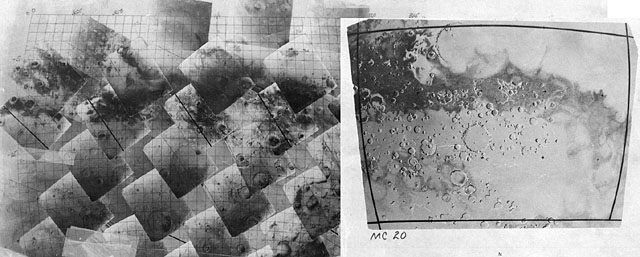

Another major space related adventure came my way when I arranged to be on a space related cruise aboard the S.S.Statendam to see Apollo 17 lift off. During the cruise I met people like Marvin Minsky, Krafft Eriche, and Robert Heinlein and saw Carl Sagan again after meeting him a couple years previously. I saw other luminaries in space, science, and entertainment. Rick Sternbach also attended the Apollo launch Cruise. It has been said the Space Movement as we know it had its genesis during that cruise in the climate of urgency brought about by the end of Apollo.
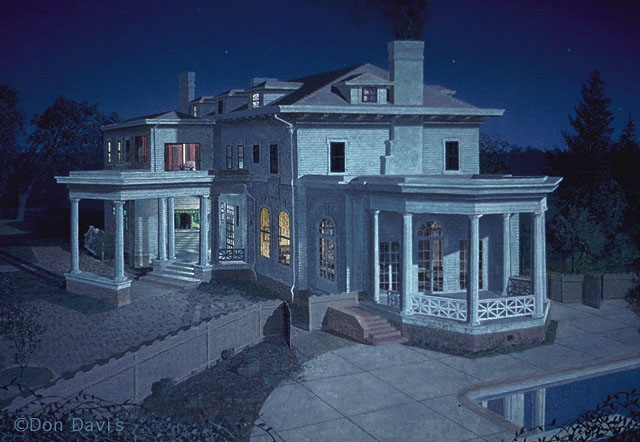
In October 1973 I moved back to the West coast, and by good fortune became a boarder in a three story mansion just purchased by Jack and Alice Cosgrove. It lay in the heavily wooded affluent community of Atherton, near an exclusive private elementary school called Peninsula School. I lived at the Mansion nine years, and used that time of relatively easy living to bring my painting abilities to some maturity.
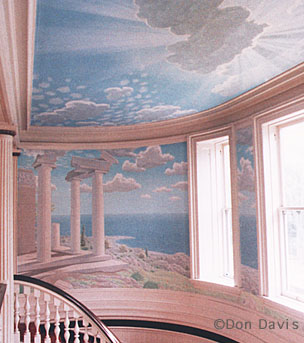
In the Classical Revival
mansion's entrance, there was an inner balcony atop a flight of
stairs, facing the inner walls of a room with rounded corners.
As you stood there, leaning on a wide handhold in between Grecian
columns, a blank panorama presented itself. I painted on these
walls a panoramic view from a cliff, with painted Greek temples
perched on green hills. The flat ocean horizon extended to the
eye level, patterns of waves crowding to the misty distance. The
ceiling was filled with billowy clouds, with sun rays spilling
out from behind them. When the morning light
filled the space with luminous light the painting made the walls
nearly vanish. 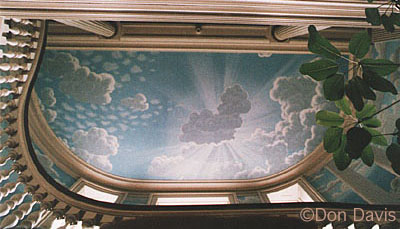
All my paintings were done in oils until the end of the 1970's, using techniques suggested as useful by Bonestell. I later took up the airbrush in earnest after working with them on Cosmos so much. For reference on one painting of the Moon I borrowed some Lunar Orbiter spacecraft prints of the Lunar far side from work. The Mare Orientale basin was at that time poorly photographed, detailed topographic information of the basins Western regions was still lacking until the recent Lunar orbiting missions finally competed our maps of the Moon.
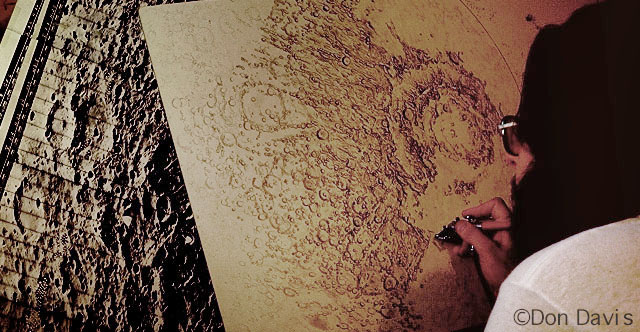
I used the USGS maps to sketch in where the crater rims, etc. would go atop a perspective drawing of a gridded sphere. The Photographs were used to actually paint from, it being important to refer to original sources whenever possible to try and maintain the fidelity of the subject matter.
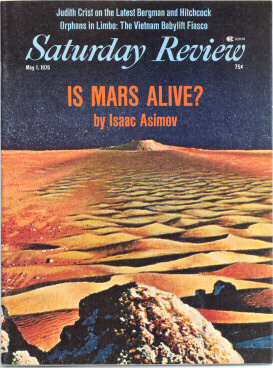
The books my work appears in include Carl Sagan's 'Cosmos', 'Pale Blue Dot', and his Pulitzer Prize winning 'The Dragons Of Eden', for which I did the cover.
Among the magazine covers my work appeared on is this May 1976 issue of Saturday Review. The work is a highly enlarged part of one panel of my first Mars panorama, done for use in the Morrison Planetarium.
Sky Publishing's recent book "The New Solar System' contains many images conveying recent discoveries of what our neighboring worlds are like and how they got that way. The earlier editions include my traditional work, the later my digital work.
Other publications include Gerard O'Neill's 'The High Frontier', and issues of 'Parade' and especially 'Sky and Telescope' magazine.
I have painted many depictions of real and imaginary projects for NASA, ranging from images of what the Voyager probes would see at the outer planets to grand schemes for the colonization of Space by millions of people. Among the most widely distributed of my NASA paintings were a series of depictions of the interiors of giant space colonies of various designs. Some of these paintings were done for NASA Ames, under the direction of Public Affairs Director Pete Waller and various experts.
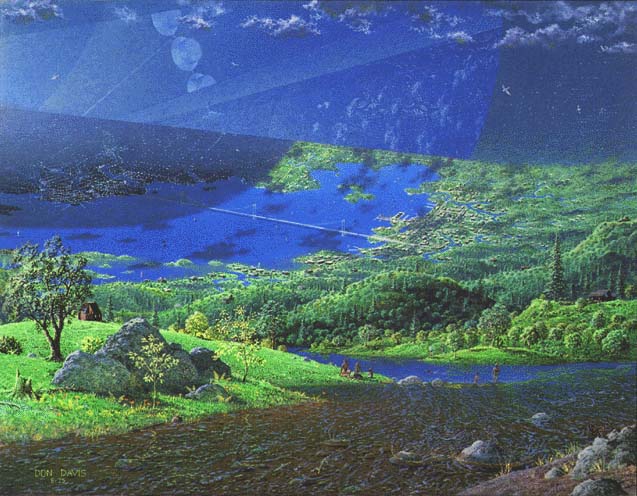
Here is what
is probably my most widely seen pre digital painting, my 'Bay
Area' derived interior for a giant cylindrical habitat design.
It was painted this way under the direction of space colonization
popularizer Gerard O'Neill himself, who related a recent
impression of the vantage point from Sausalito being an excellent
scale reference for a possible setting inside a later model cylindrical
colony. When this painting appeared on the cover of the 'Co-Evolution
Quarterly' 1975 book 'Space Settlements' editor Stewart Brand
wrote in the caption "The painting of the interior of a "Model
III" cylindrical Space Colony by Don Davis appears on the
cover of Space Colonies. It has inspired more belief and roused
more ire than any other artifact associated with Space Colonies
so far. The man-made idyll is too man-made, too idylliic or too
ecologically unlikely - say the ired. It's a general representation
of the natural scale of life attainable in a large rotating environment
- say the inspired. Either way, it makes people jump." I
deliberately wanted to imply the challenge of trying to transplant
a workable ecosysyem to a giant terrarium in Space. Most other
depictions are dreary mega-shopping mall like structures filling
the available volume. I still consider the Space Colony option
a more realistic means for establishing large population bases
off the Earth rather then any Terraforming schemes, except perhaps
hollowing out solid asteroids if there are any.
My art has appeared on a million selling record
album by the Jefferson Starship, (Earth), appearing on the inner
sleeve and the labels of the record.
A series of permanent exhibits in the Hall of Meteors of the Smithsonian's National Museum of Natural History includes a series of digitally prepared murals, and animations of the solar System's formation and the destructive impact on Earth 65 million years ago. In the neighboring Air and Space Museum a transparency of a commissioned painting shows the violent departure of a rock in an exhibit case from the surface of Mars. A series of paintings of the formation of Meteor Crater in Arizona, formally on exhibit in its museum, are still available in their gift shop as a set of postcards. Next time you're there ask to see the originals up again!
In addition to my painting, the world of visual effects for film and video media became prominent in my career.
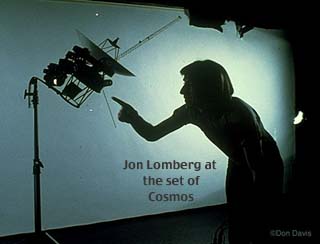 At the end of the
1970's, artist Jon Lomberg gathered talent from across the country
to work on the PBS series 'Cosmos'. The working relationship he
had with Carl Sagan, his friend and collaborator, coupled with
his reaching out to the community of space artists when the 'Cosmos'
series went into production, enabling a galvanization of the artistic
resources devoted to Space. I provided the authentic appearance
to the planetary surface models, giving art direction as well
as personally building terrain models of the surfaces of various
planets and moons. Most of these were 'table top' models of the
Martian surface, and various moons of the outer Solar System.
At the end of the
1970's, artist Jon Lomberg gathered talent from across the country
to work on the PBS series 'Cosmos'. The working relationship he
had with Carl Sagan, his friend and collaborator, coupled with
his reaching out to the community of space artists when the 'Cosmos'
series went into production, enabling a galvanization of the artistic
resources devoted to Space. I provided the authentic appearance
to the planetary surface models, giving art direction as well
as personally building terrain models of the surfaces of various
planets and moons. Most of these were 'table top' models of the
Martian surface, and various moons of the outer Solar System.
The greatest project I undertook for the show
was the crafting of a 3 foot diameter Earth globe, with 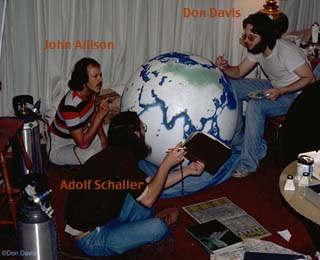 intricate coastline detail. It was like painting
a 4 by 8 foot extremely accurate pictorial map including surface
relief using acrylic gel medium. Between the early work done by
the team of artists and the extended finishing touches I lavished
on the thing, a good quarter years worth of work went into it.
It was smashed through careless handling, I grieved, repaired
it with heroic measures, and after it was filmed it got smashed
again. I have since created superior globes using digital methods.
intricate coastline detail. It was like painting
a 4 by 8 foot extremely accurate pictorial map including surface
relief using acrylic gel medium. Between the early work done by
the team of artists and the extended finishing touches I lavished
on the thing, a good quarter years worth of work went into it.
It was smashed through careless handling, I grieved, repaired
it with heroic measures, and after it was filmed it got smashed
again. I have since created superior globes using digital methods.
I barely touched any of the voluminous cell animation which filled the balance of the 'Cosmos' effects portraying galaxies, nebula, and such.
Several artists came away from the experience with careers propelled into high gear, and the importance of this initial 'break' into a business notoriously hard to get started in was never lost on me. I was to win an Emmy for my work on the 'Cosmos' series along with the other members of the core team of artists.
Since then I have periodically contributed to TV and film projects with requested elements or full fledged involvement.
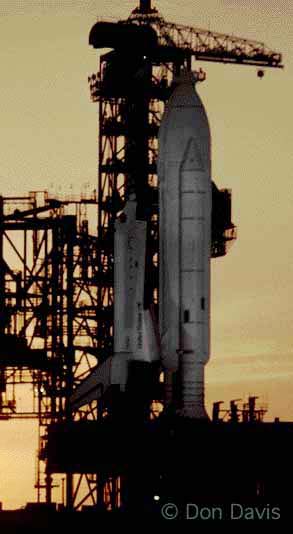
I have tried to be at extraordinary events for the experience itself as well as to bring back my impressions and images. One such event was the first launch of the Shuttle on April 12, 1981. Since I had seen the last Apollo expedition take off, I decided to see the beginning of another space era. This photo was taken during a 'pad tour' the evening before the first launch attempt. I also saw the last Shuttle launch.
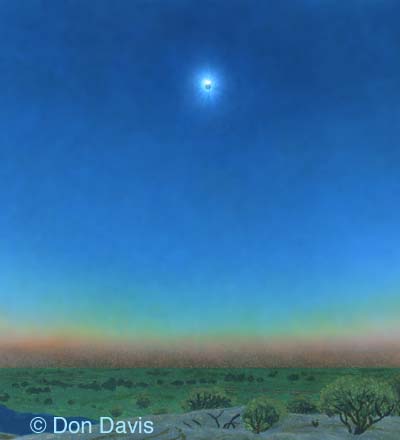
Another such event I experienced was the February 16, 1980 total eclipse of the sun in India. This oil painting done soon after returning home conveys the start of totality, as the last bit of the sun disappears behind the moon briefly bringing the 'diamond ring' appearance so often commented on.
Among the longest term outlets for my work has been the Planetarium field, and what it is evolving into.
It was at a Planetarium run by Curt Warren at the Rosicrucian Egyptian Museum complex in San Jose that I had my first Planetarium experience as a young boy taken there on a class field trip. (Also on exhibit there were a series of little dioramas based on art from 'The Conquest Of Space', a book I would not see for a few years.)
My first work for a Planetarium was in late 1969 when a series of paintings and a model for a film sequence in a 'Grand Tour of the planets' show at Morrison Planetarium were commissioned. These were done under the supervision of Associate Director at the time Don Warren, Curt Warrens brother! For that time the effects were fairly elaborate for the medium-high end facility such as Morrison was at that time. A later mars panorama, based on Mariner 9 revelations about the planet, was done for Morrison. An excerpt of this work was reproduced on the cover of the then widely circulated magazine 'Saturday Review', shown above.
In 1987 I joined the staff
of Hansen Planetarium as an artist for shows and publications.
In the course of my employment at Hansen, then among the premier
facilities in the world, I participated in many of the activities
involved in show production.
Hansen was one place where the advances
in the field of illusionistic multiple projections, a centuries
old art, were given full use. Great talent contributed to every
step of the show production. Director Mark Littmann was the primary
instigator of this standard of excellence at Hansen, and under
his leadership the art of Planetarium productions there were elevated
from dull constellation identification shows (to generalize, of
course) to dramatic presentations. The first science fiction show
I saw in a Planetarium was 'The Final Journey' in 1972 which was
a Hansen show imported due to the efforts of Donald McDonald,
Director of the Minolta Planetarium in nearby Cupertino. It was
the first time I had seen the potential of a dramatic presentation
in a domed theater. Hansen began selling
its shows in packages from which other smaller facilities could
build from, and was one of perhaps two or three major Planetariums
which were most influential in breathing life into the medium.
Then movies like '2001' were bringing despair to many in the field.
In the end being part of a political entity is nearly as ephemeral as being in RAM on your computer without being saved. Hansen was to learn this bitterly on more than one occasion to come.
After Mark Littmann's departure Von Del Chamberlain continued the trend of pushing the limits of show production with the skills of the largely Littmann era staff. So versatile were many of the production staff some of them would eventually write and supervise the production of shows. In a way producing a show was the ultimate thing you could aspire to after 'getting your legs' in the Production Department for a year or so. I was to ultimately climb this ladder and have the chance to create audience experiences using the resources of one of the finest Planetariums in the World. Twice I was Artistic Director of full blown show productions, where my activities included participation in preparation of scripts, art, and even designing an effects projector.
The late 1980's was the twilight of the era in which the highly refined 'lantern slide show' technology ruled the domed theater. Soon the days of the machine shops with a half dozen fabricators of custom effects projectors for each show would vanish. The Hansen Planetarium's Digistar projector, and later their Macintosh computers, provided my first continuous exposure to computer graphic show production methods. Creation of models on the Digistar for these shows was an early use of computer graphics. The first decent production quality Macs were coming out then, and the paint tools available, while crude, were enough to make the power of digital media obvious to me.
 Director
Von Del Chamberlain was at the helm when Hansen in its original
downtown building was at its peak of attainment. His first love
was Archeoastronomy, especially involving ancient American peoples.
Director
Von Del Chamberlain was at the helm when Hansen in its original
downtown building was at its peak of attainment. His first love
was Archeoastronomy, especially involving ancient American peoples.
When I asked his appraisal of the chances of this famous rock art at Chaco Canyon being a record of the 1054 supernova event, he said this was virtually the only site of such a drawing known to be inhabited in 1054 A.D., but the appearance of brilliant Venus near the crescent Moon was far more common and likely to be portrayed.
It was never my plan to stay in Salt Lake forever, and three years ended up being just fine. In 1990 Hansen Planetarium was increasingly uncertain about its future.
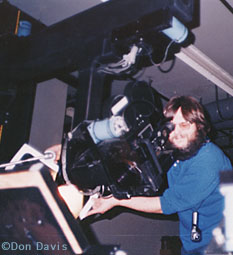 I
left to take a job in Glendale doing special visual effects work
for the PBS shows 'Infinite Voyage' and 'Space Age'. The work
included model building, art and animations, and learning to use
a 35mm motion control camera. I had actually shot all of my Galileo
35mm animation on this system at after hours, with the initial
instruction of facility supervisor John Allison and the sustained
assistance of Connie Conrad. In the end I was able to load
and operate the camera and even execute bi-pack mattes myself,
a grueling 8 hour task. The camera motion control system was designed
and built by Pat Tiffen, with software written by Bill Tondreau.
When we finally began to look towards buying a computer graphic
capability in 1991 the software recommended by another builder
of motion control rigs, Joe Lewis, was a brand new rendering package
largely created by his acquaintances Jay Roth and Mark Grainger,
called Electric Image.
I
left to take a job in Glendale doing special visual effects work
for the PBS shows 'Infinite Voyage' and 'Space Age'. The work
included model building, art and animations, and learning to use
a 35mm motion control camera. I had actually shot all of my Galileo
35mm animation on this system at after hours, with the initial
instruction of facility supervisor John Allison and the sustained
assistance of Connie Conrad. In the end I was able to load
and operate the camera and even execute bi-pack mattes myself,
a grueling 8 hour task. The camera motion control system was designed
and built by Pat Tiffen, with software written by Bill Tondreau.
When we finally began to look towards buying a computer graphic
capability in 1991 the software recommended by another builder
of motion control rigs, Joe Lewis, was a brand new rendering package
largely created by his acquaintances Jay Roth and Mark Grainger,
called Electric Image.
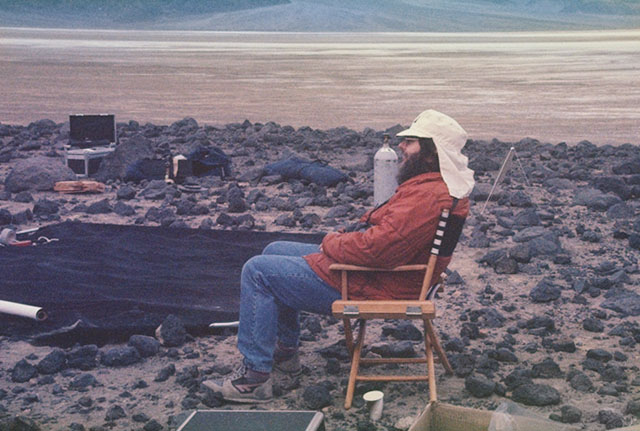
On the
'set' of the PBS show 'Space Age', atop 'Mars Hill' in Death Valley,
also site of the 1983 Space Artist's workshop from which the Space
artist group, the International Association of Astronomical Artists,
emerged. I based a painting of Mars on the view from the neighboring
hill. Two TV shows have now used this site to simulate Mars landings,
and designs for rovers are brought here to see how they fare in
this rehearsal for the rugged surfaces seen there.
Later we purchased Macintosh
II FX, with the then whopping 32 megabytes of RAM. We used this,
and an early version of ElectricImage software, to create our
first computer animations.
I saw the last days of film dominated effects,
with immense work required to composite layers of images giving
way to Digital methods of incomparable ease and speed. The cavernous
industrial spaces and sound stages are largely being replaced
by computer generated environments, the heroic struggles of lighting
and pulling mattes from models have become a memory to be laughed
at. What once required many people in large facilities to do is
now possible for many individuals and small groups working out
of houses and garages. The computer has greatly 'decentralized'
such work.
Now I create art and animations for various
television shows and video projection in Planetariua on my desktop.
The machines get faster and I keep piling on
the work to slow them back down!
All the following reduced frames were rendered in the animation software ElectricImage.
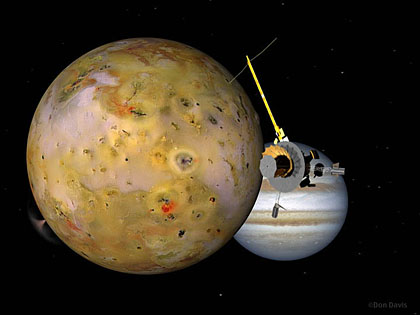
Here is a frame from one of my TV animations for The learning Channel of Galileo passing Io, something its cameras never got to see due to the mesh antennae not opening completely.
This rendering uses a highly detailed polygonal model of the Moon I created from various sources and a lot of hand drawn 'digital elevation mapping'. A cleaned up Clementine spacecraft photo mosaic has been colored to match the hues of lava flows such as those along eastern Mare Serenitatus. For several years that elevation map was the best one available, and was used as the basis for a bronze Moon globe at the Rose Center/Hayden Planetarium in New York.
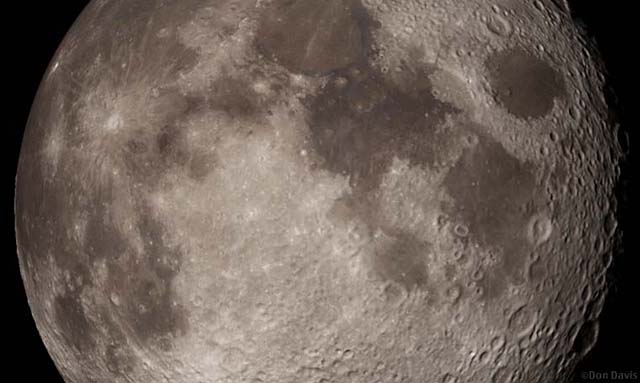
This is a sample of an all-sky rendering of a surfa ce model I made of Pluto, with a thin crescent Charon in the digital sky'. More space renderings can be seen here.
Space is still my main subject, although I have interest in Dinosaurs and ancient architecture.
The musician IASOS has a visionary artists gallery on his splendid site, here is my work on exhibit there
Experience:
2011-12 Evans and Sutherland
*computer animation for 3D 'Robot Explorers' show
2009-10 Evans and Sutherland
*computer animation for 'Secret Lives Of Stars' show
2008-09 Evans and Sutherland
*computer animation for 'Violent Universe' show (Trailer)
2007 Evans and Sutherland
*computer animation for 'Invaders Of Mars' show
Public Broadcasting System
* computer animation for PBS special 'Seeing In The Dark' written and narrated by Timothy Ferris.
2006 Evans and Sutherland
*computer animation for 'Seven Wonders of the Universe'2006 Evans and Sutherland
*computer animation for 'Seven Wonders of the Universe'
2005 Evans and Sutherland
*computer animation for 'Secrets of the Sun'
Spacecraft Films
* Computer animation of Apollo 16 landing site for Apollo 16 DVD.
2004 Evans and Sutherland
*computer animation for 'Seven Wonders of the Ancient World'
Calgary Science Centre
*Star and galaxy animations for 'Quest for Origins'
2003 Evans and Sutherland
* computer animation for domed theater presentation 'Universe'.
Spacecraft Films
* Computer animation of Apollo 17 landing site for Apollo 17 DVD.
2002 Evans and Sutherland
* 22 minutes of computer animation for domed theater presentation 'Cosmic Safari', depicting extraterrestrial life.
Spacecraft Films
* Computer animation of Apollo 15 landing site for for Apollo 15 DVD.
2001 Evans and Sutherland
* 22 minutes of computer animation for domed theater presentation 'New Horizons', featuring our solar system.
2000 Evans and Sutherland
* 20 minutes of computer animation for domed
theater presentation 'Wonders Of The Universe'.
1999 Invincible films London
* CGI animation sequences for TLC shows 'Savage Sun', and
'Cosmic Safari'.
1999 SIMEX Digital Studios,Santa Monica, CA
*Art direction and visual elements for end sequences of Japanese animated film 'The Laws Of The Sun'.
1999 Public Broadcasting System
*CGI art and animation sequences for PBS show
'Life Beyond Earth', written
and narrated by Timothy Ferris.
1998 Astronomical animations rendered for Sky Vision all-dome projection system, premiered at the International Planetarium Society in London, June 1998
Illustrations for the 4th edition of 'The New Solar System', by Sky Publishing Corp.
1997 Smithsonian Institution Washington, D.C.
* CGI animations for Hall of Meteorites at National Museum
of Natural History
of a tour of Solar System, and an asteroid impact on Earth.
*Large scale Earth texture maps for wall sized animation used in 'Star Trek-The Experience, Las Vegas.
1996 -7 York Films of England London, England
* CGI art and animation sequences for television series 'Solar
Empire'
1996 John Allison Co., Sherman Oaks, CA
* CGI animation sequence of Mt. St. Helens
eruption for St Helens visitors
center exhibit
1995-6 Jet Propulsion Laboratory, Pasadena, CA
*CGI animations of launch and deployment of TOPEX and ADEOS satellites
1995 Industrial Light and Magic, San Rafael, CA
*Digital matte paintings for feature film 'Congo' and various
commercials
1994 York Films of England London, England
*Painted texture maps and provided art for The Learning Channel
television series "Wonders Of The Universe"
1990-1992 WQED science effects Glendale, CA
*Painted backgrounds and prepared models for Public Broadcasting
Television
shows "Infinite Voyage" and "Space Age"
*Designed and fabricated computer models and
animation sequences
1989 NASA-Ames Research Center Mountain View,
CA
Artist and animator
*Designed, painted, and filmed 35mm cel animation depicting Galileo
probe
entry and descent into Jupiter's atmosphere, widely shown during
encounter
1987-1990 Hansen Planetarium Salt Lake City,UT
Illustrator for shows and publications
*Created art and graphic 'models' using 'Digistar'
projection system
*Artistic Director for 2 planetarium shows
*Special effects projector design working with technical staff
1984-1985 Public Broadcasting Hollywood, CA
Model maker, Artist, Animator for "Planet Earth" series
*Painted and sculpted Earth globes to simulate space appearance
and topography
*Designed and painted cel animation sequences of planetary impact
events
Additional Information
*Awarded an Emmy for work on "Cosmos" television series
*Awarded 2002 Klumpke Roberts award by the Astronomical Society of the Pacific for lifetime achievement in the popularization of astronomy
*Asteroid 13330 dondavis named in 2003
*Fellow of the International Association of Astronomical Artists
*Covers and interior artwork for many science and space oriented publications